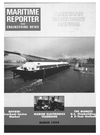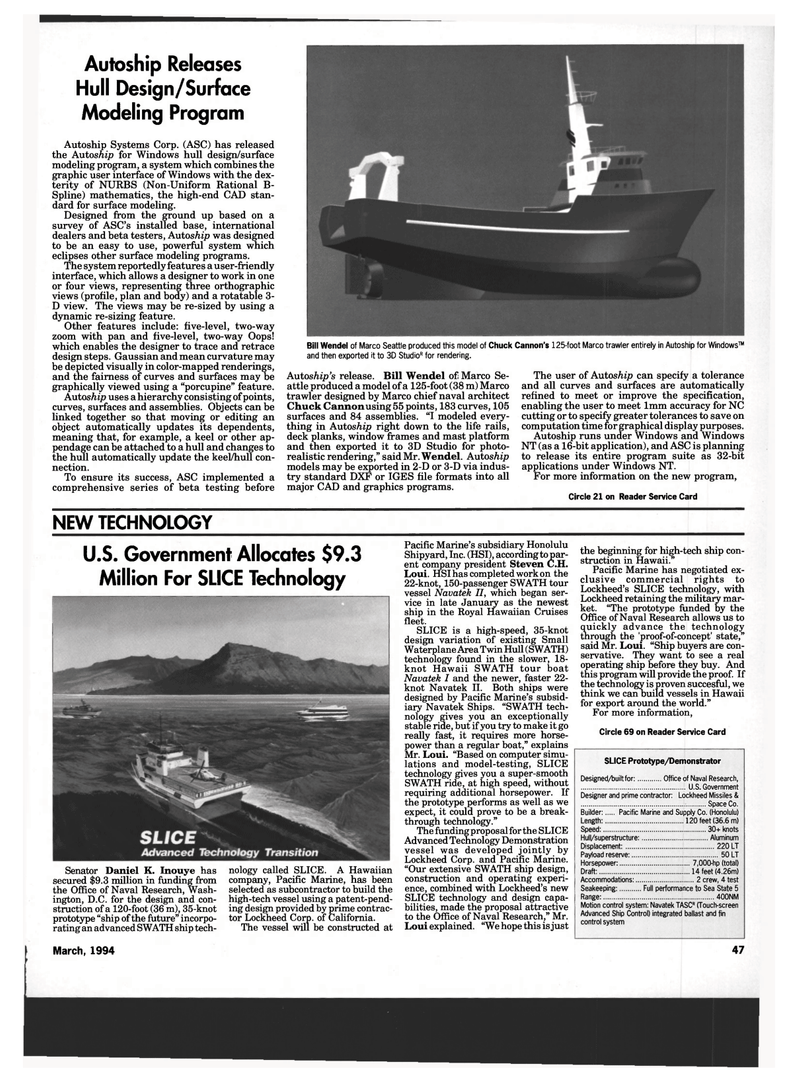
Page 45: of Maritime Reporter Magazine (March 1994)
Read this page in Pdf, Flash or Html5 edition of March 1994 Maritime Reporter Magazine
Autoship Releases
Hull Design/Surface
Modeling Program
Autoship Systems Corp. (ASC) has released the Auto ship for Windows hull design/surface modeling program, a system which combines the graphic user interface of Windows with the dex- terity of NURBS (Non-Uniform Rational B-
Spline) mathematics, the high-end CAD stan- dard for surface modeling.
Designed from the ground up based on a survey of ASC's installed base, international dealers and beta testers, Auto ship was designed to be an easy to use, powerful system which eclipses other surface modeling programs.
The system reportedly features a user-friendly interface, which allows a designer to work in one or four views, representing three orthographic views (profile, plan and body) and a rotatable 3-
D view. The views may be re-sized by using a dynamic re-sizing feature.
Other features include: five-level, two-way zoom with pan and five-level, two-way Oops! which enables the designer to trace and retrace design steps. Gaussian and mean curvature may be depicted visually in color-mapped renderings, and the fairness of curves and surfaces may be graphically viewed using a "porcupine" feature.
Auto ship uses a hierarchy consisting of points, curves, surfaces and assemblies. Objects can be linked together so that moving or editing an object automatically updates its dependents, meaning that, for example, a keel or other ap- pendage can be attached to a hull and changes to the hull automatically update the keel/hull con- nection.
To ensure its success, ASC implemented a comprehensive series of beta testing before
Bill Wendel of Marco Seattle produced this model of Chuck Cannon's 125-foot Marco trawler entirely in Autoship for Windows™ and then exported it to 3D Studio" for rendering.
Autos/iip's release. Bill Wendel of Marco Se- attle produced a model of a 125-foot (38 m) Marco trawler designed by Marco chief naval architect
Chuck Cannonusing 55 points, 183 curves, 105 surfaces and 84 assemblies. "I modeled every- thing in Autos/iip right down to the life rails, deck planks, window frames and mast platform and then exported it to 3D Studio for photo- realistic rendering," said Mr. Wendel. Auto ship models may be exported in 2-D or 3-D via indus- try standard DXF or IGES file formats into all major CAD and graphics programs.
The user of Autoship can specify a tolerance and all curves and surfaces are automatically refined to meet or improve the specification, enabling the user to meet 1mm accuracy for NC cutting or to specify greater tolerances to save on computation time for graphical display purposes.
Autoship runs under Windows and Windows
NT (as a 16-bit application), and ASC is planning to release its entire program suite as 32-bit applications under Windows NT.
For more information on the new program,
Circle 21 on Reader Service Card
NEW TECHNOLOGY
U.S. Government Allocates $9.3
Million For SLICE Technology
Senator Daniel K. Inouye has secured $9.3 million in funding from the Office of Naval Research, Wash- ington, D.C. for the design and con-struction of a 120-foot (36 m), 35-knot prototype "ship of the future" incorpo-rating an advanced SWATH ship tech-
March, 1994 nology called SLICE. A Hawaiian company, Pacific Marine, has been selected as subcontractor to build the high-tech vessel using a patent-pend- ing design provided by prime contrac-tor Lockheed Corp. of California.
The vessel will be constructed at
Pacific Marine's subsidiary Honolulu Shipyard, Inc. (HSI), according to par- ent company president Steven C.H. Loui. HSI has completed work on the 22-knot, 150-passenger SWATH tour vessel Navatek II, which began ser- vice in late January as the newest ship in the Royal Hawaiian Cruises fleet. SLICE is a high-speed, 35-knot design variation of existing Small Waterplane Area Twin Hull (SWATH) technology found in the slower, 18-knot Hawaii SWATH tour boat
Navatek I and the newer, faster 22-knot Navatek II. Both ships were designed by Pacific Marine's subsid-iary Navatek Ships. "SWATH tech- nology gives you an exceptionally stable ride, but if you try to make it go really fast, it requires more horse-power than a regular boat," explains
Mr. Loui. "Based on computer simu-lations and model-testing, SLICE technology gives you a super-smooth SWATH ride, at high speed, without requiring additional horsepower. If the prototype performs as well as we expect, it could prove to be a break-through technology."
The funding proposal for the SLICE Advanced Technology Demonstration vessel was developed jointly by Lockheed Corp. and Pacific Marine. "Our extensive SWATH ship design, construction and operating experi- ence, combined with Lockheed's new SLICE technology and design capa- bilities, made the proposal attractive to the Office of Naval Research," Mr.
Loui explained. "We hope this is just the beginning for high-tech ship con-struction in Hawaii."
Pacific Marine has negotiated ex-clusive commercial rights to
Lockheed's SLICE technology, with Lockheed retaining the military mar- ket. "The prototype funded by the Office of Naval Research allows us to quickly advance the technology through the 'proof-of-concept' state," said Mr. Loui. "Ship buyers are con-servative. They want to see a real operating ship before they buy. And this program will provide the proof. If the technology is proven succesful, we think we can build vessels in Hawaii for export around the world."
For more information,
Circle 69 on Reader Service Card
SLICE Prototype/Demonstrator
Designed/built for: Office of Naval Research,
U.S. Government
Designer and prime contractor: Lockheed Missiles &
Space Co.
Builder: Pacific Marine and Supply Co. (Honolulu)
Length: 120 feet (36.6 m)
Speed: 30+ knots
Hull/superstructure: Aluminum
Displacement: 220 LT
Payload reserve: 50 LT
Horsepower: 7,000-hp (total)
Draft: 14 feet (4.26m)
Accommodations: 2 crew, 4 test
Seakeeping: Full performance to Sea State 5
Range: 400NM
Motion control system: Navatek TASC" (Touch-screen
Advanced Ship Control) integrated ballast and fin control system 47

 44
44

 46
46
